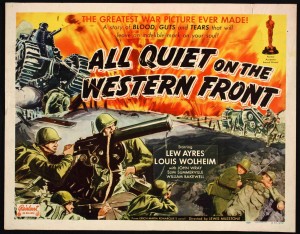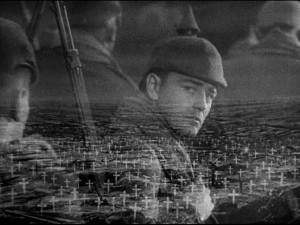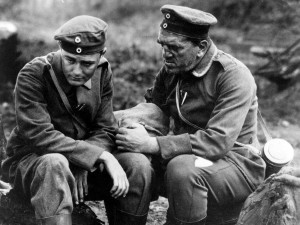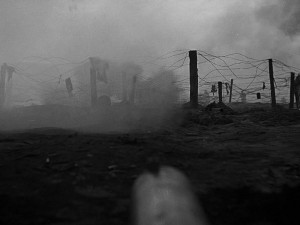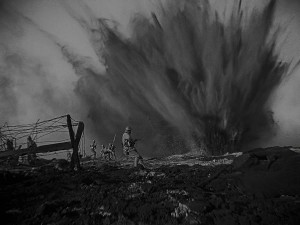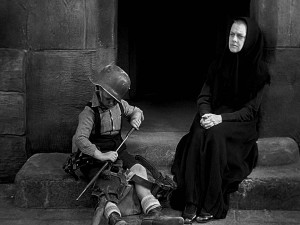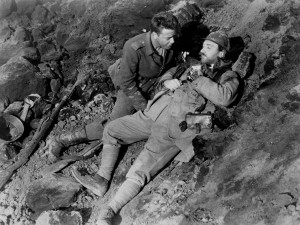#1 – All Quiet on the Western Front
Accolades:
1929-30 Academy Awards
Best Picture
Best Director
AFI 100 Years… 100 Movies (1998)
Ranked #54
Contemporary review:
(it should) be shown every year until the word War shall have been taken out of the dictionaries. – Variety, 1930
Electric Shadows rating: ![]()
The lowdown: One of the most recognisable movie titles in history is also one of the best war films ever made. An impassioned plea for tolerance and an unflinching view of conflict at its most terrifying, its DNA is present in every war movie since, including Kubrick’s Paths of Glory, Stone’s Born on the Fourth of July and Spielberg’s Saving Private Ryan. Lew Ayres is the young German soldier who has the nationalism battered out of him over three nightmare years in the trenches. Small wonder the Nazis released rats into theatres showing the film, before banning it outright when coming to power.
The full verdict: If all the people who read a bestseller saw the movie adaptation, the film would be a flop. So, it’s to Universal Studios credit that in 1929, months after the stock market crash, they put $1.2m into an adaptation of Erich Maria Remarque’s semi-autobiographical novel.
And the money is up there on screen – what impresses modern audiences weaned on countless wars vividly brought to life with bleeding edge FX is how shattering and enormous All Quiet on the Western Front’s battle scenes are.
Suicide attack missions between massive shell explosions and close-quarter trench fighting are depicted with a ferocity that hits like a bullet to this day and must have been overwhelming to audiences almost 100 years ago, the visuals coupled with a sound design of screeching bombs and deafening explosions.
Silver screen death had never been this squalid; hands clutching barb wire are all that remains of a shell attack, the protagonist Paul forced to share a crater with a French soldier who takes forever to die, a callow recruit blinded and then shot on the battlefield.
All this contributed to the film’s myriad versions over the years, but what got it banned in Germany, Italy, Austria and Australia was the anti-authoritarian message at its core. It was most likely the reason for a ban in France too, along with a scene suggesting French women were all too willing to lie with German soldiers.
The straightforward plot, a template for most war films since, follows a class of German schoolboys fired up by their aging teacher’s nationalist rhetoric.
In basic training they discover their instructor is the town postman, now a petty despot due to the uniform he wears.
When on the frontline, the soldiers ruminate on the causes of war, with dialogue about the politicians fighting their own wars that resonates to this day and foreshadows the tragic events that were to follow 9 years later.
Although the episodic structure, theatrical acting and some sledgehammer speechifying place All Quiet On The Western Front firmly in the 1930s, director Milestone’s single minded vision of exposing war’s insanity to harsh light hits hard.
Sanity smashing shelling in rat infested trenches, a grim running gag showing a single pair of boots moving from one amputee victim to the next, the despair of discovering school teachers prepping more boys for the sausage machine, it’s all included.
The strong American accents (a silent version was shot simultaneously) and hardboiled rat-a-tat dialogue may seem incongruous, but contribute to the film’s message that unchecked nationalism make enemies of likeminded people.
A 1939 re-release added a voiceover decrying the Nazi threat, but also served as a reminder of war’s horror. A bitter postscript is that WWI really was outperformed by its sequel.
Milestone won an Oscar for his direction, his second after Two Arabian Nights in 1927. But, this vaunted film suffered butchery for decades after its release, up to 35 minutes being gouged from the running time and music added to the largely score-free film, including the famous final scene.
In 1980, before his death Milestone implored Universal to restore the film to its original version. The Library of Congress fulfilled his wish in 1998.
Rob Daniel
[youtube id=”aiObc2XmVqw”]

